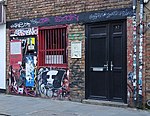The Goodsyard
The Goodsyard is a proposed development on the site of the former Bishopsgate Goods Yard in Shoreditch, London. It spans the border between the two London boroughs of Hackney and Tower Hamlets. The scheme, which is a joint venture between developers Hammerson and Ballymore, previously included 12 buildings, the tallest of which was planned to be 166-metre (545 ft) tall with 46 floors. In total, 1,356 homes were proposed, as well as offices, retail and workshop space and a 0.97-hectare (2.4-acre) park. In 2015, the then London Mayor Boris Johnson called in the scheme, which gave him the authority to grant or reject planning permission. A decision was due in April 2016 but was delayed, before the plans were withdrawn in April 2016 following concerns by Greater London Authority (GLA) that the proposals did not provide enough affordable housing and the buildings could block out light to the surrounding area. In July 2016 the developers announced that the plans will be redesigned over the next year. The proposed development has received opposition from heritage bodies and local residents. It is also opposed by Hackney and Tower Hamlets Borough Councils.
Excerpt from the Wikipedia article The Goodsyard (License: CC BY-SA 3.0, Authors).The Goodsyard
Braithwaite Street, London Whitechapel
Geographical coordinates (GPS) Address Phone number Website Nearby Places Show on map
Geographical coordinates (GPS)
| Latitude | Longitude |
|---|---|
| N 51.522893 ° | E -0.075718 ° |
Address
Lucozade Power League
Braithwaite Street
E1 6GJ London, Whitechapel
England, United Kingdom
Open on Google Maps











